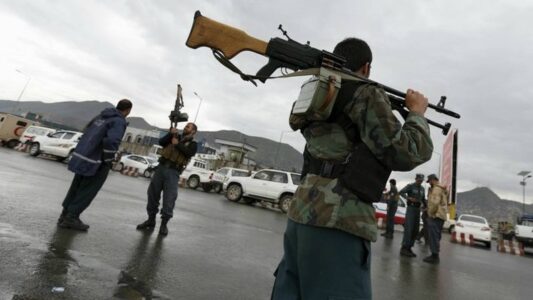
Islamic State and Al-Qaeda terrorist groups set to reconstitute in Afghanistan
With U.S. and coalition combat troops all but gone from Afghanistan, Western officials are preparing to face down terrorist threats with the promise of “over-the-horizon” capabilities that may be ill-suited to the danger that groups such as al-Qaida and Islamic State currently pose.
U.S. officials, both publicly and privately, insist both terror groups are a shadow of their former selves. Al-Qaida, they say, commands maybe several hundred fighters across Afghanistan, while the Islamic State’s Afghan affiliate, IS-Khorasan, has slightly more.
And while IS-Khorasan has claimed responsibility for several high-profile attacks, especially in urban areas, intelligence and humanitarian officials say that both groups are unlikely to do anything that would make them an easy target for U.S. bombers or drones flying into Afghanistan from afar.
“Al-Qaida, probably for the foreseeable future, is probably going to tie its fortunes very closely with the Taliban,” one Western counterterrorism official told VOA.
“They’re going to want to reassure the Taliban that they’re not going to embarrass them,” the official added, speaking on the condition of anonymity in order to discuss sensitive intelligence matters. “They’re going to want to keep Afghanistan a place from which they can recruit, train.”
IS-Khorasan, which no longer holds territory in Afghanistan, as it once did, has also been laying the foundation for a revival.
“IS-Khorasan is not done and is an organization that still has the potential to gain in strength in spite of the recent difficulties that it’s faced,” the counterterrorism official said. “You can see certain circumstances in which IS-Khorasan could grow stronger, may attract additional fighters, and may gain additional freedom of action.”
Observers in the region warn that IS-Khorasan has also begun looking beyond Afghanistan itself and is attempting to gain footholds in Kazakhstan, Kyrgyzstan and parts of Tajikistan.
One humanitarian official in Central Asia, who asked that their name be withheld due to fears they could be targeted, told VOA that the focus was on “more quality and less numbers.”
“They are building local infrastructure for the recruitment, logistics, economic support, economic infrastructure to support that,” the official said. “At the moment, they have a need to recruit more IT-savvy guys, rather than just a regular soldier who’s ready to become a suicide bomber.”
Such concerns are being echoed by both U.S. and Central Asian officials.
A Pentagon report issued this past April called the expansion of IS-Khorasan “a top concern” for Afghanistan’s neighbors, adding that the terror group was “creating the potential for destabilization.”
U.S. intelligence likewise believes there is reason to worry, given that IS-Khorasan “has historically attracted some of its recruits from Central Asian countries,” according to one official who asked not to be identified in order to discuss intelligence matters.
Central Asian countries “are prioritizing regional security and stability by pursuing regional cooperation and improving their counterterrorism capabilities and border security,” the official added.
Uzbekistan’s ambassador to the United States, Javlon Vakhabov, confirmed to VOA that his country remains “very interested” in working with Washington to strengthen border security, with an eye toward stemming the spread of IS-Khorasan.
“We have always been concerned about such recruitments,” Vakhabov said. “They have devastative multiplicative influence not only to the recruited but also to his/her families and children.”
Other Central Asian officials also have been talking with the U.S. about securing their borders as the U.S. military presence in Afghanistan comes to an end, with the foreign ministers of Tajikistan and Uzbekistan engaging in meetings at the State Department and the Pentagon earlier this month.
“Afghanistan’s neighbors share our interest in a stable Afghanistan and countering terrorist threats,” a State Department official told VOA.
Yet getting an accurate understanding of those threats is only going to get more difficult now that U.S. forces in Afghanistan are mostly reduced to a presence in the capital of Kabul and a contingent at Kabul airport.
CIA Director Bill Burns warned lawmakers in April that withdrawing from Afghanistan would hamper his agency’s ability to collect intelligence. “That’s simply a fact,” he said at the time.
And already there are growing discrepancies when it comes to assessing the strength of terror groups such as IS-Khorasan.
U.S. officials have put the number of IS-Khorasan fighters at several hundred. But intelligence shared by United Nations member states suggests the tally may be much higher, with a core group of 1,500 to 2,200 fighters in Afghanistan’s Kunar and Nangarhar provinces.
“Their recruitment has also expanded well beyond their traditional original appeal in far eastern Afghanistan,” according to Andrew Watkins, a senior Afghanistan analyst with International Crisis Group.
“Cells of Islamic State affiliates now appear to operate within Kabul, Parwan and Baghlan provinces, and perhaps elsewhere in the country,” he said. “What was once a group rooted in cells of displaced Pakistani militants has taken root in a range of communities or individuals sympathetic to Salafism.”
Reports of Afghan security forces taking down large IS-Khorasan cells around Mazar-e-Sharif, in Balkh province, suggest the numbers could be higher still. And there are few estimates for IS-Khorasan numbers in neighboring countries.
Despite intelligence suggesting IS-Khorasan is rebounding from substantial losses — some inflicted at the hands of the Taliban — some counterterrorism officials are wary.
Source: VOA News





